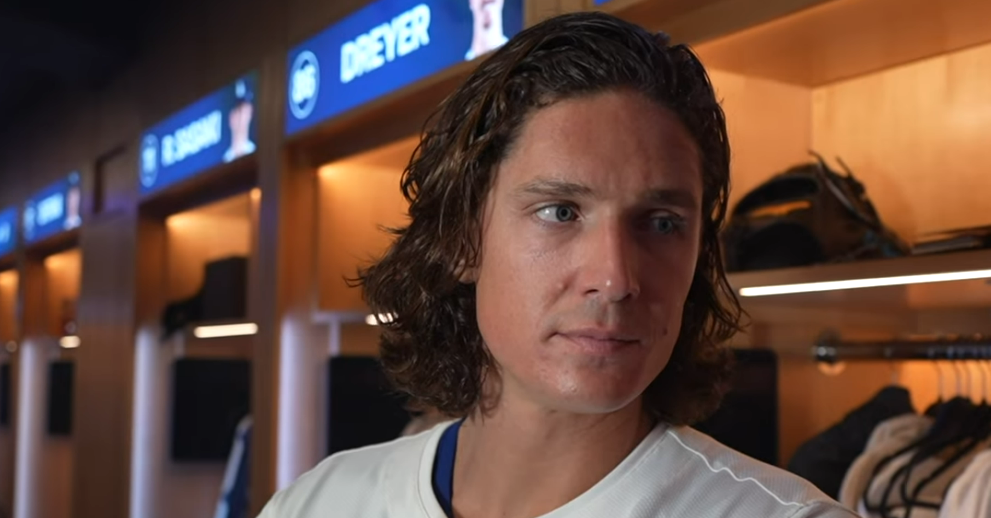The Los Angeles Dodgers ace, who stands an impressive 6 feet 8 inches tall, redefines presence on a baseball mound. His height is a distinguishing characteristic that defies the laws of pitching physics; it is not just a detail. It is almost cinematic to see him throw; it’s like watching a sculpted force of accuracy move slowly in unison with power.
Because of his height, Glasnow has a naturally steep release point, which causes fastballs to fly toward the plate from an almost unfair angle. The ball appears to ascend in midair thanks to his fluid yet powerful delivery. His 6’8″ frame allows for an optical illusion that makes his pitches “leap” out of his hand, according to batters. When his fastball frequently reaches 100 mph, that inch differential translates into milliseconds less response time for opponents—a tremendously effective advantage.
Analysts argued for years whether height benefited or hurt pitchers. By using his lengthy limbs as a precisely calibrated instrument of torque and balance, Glasnow has provided an answer to that question. He has turned his body into an efficient engine by perfecting every movement, from the height of his leg lift to the cadence of his stride. In addition to being strong, his mobility is incredibly efficient, squandering no movement, energy, or chance.
Personal and Professional Information
| Full Name | Tyler Allen Glasnow |
|---|---|
| Born | August 23, 1993 – Newhall, California, U.S. |
| Height | 6 ft 8 in (203 cm) |
| Weight | 225 lbs (102 kg) |
| Bats/Throws | Left / Right |
| Team | Los Angeles Dodgers (#31) |
| Position | Pitcher |
| MLB Debut | July 7, 2016 (Pittsburgh Pirates) |
| Previous Teams | Pittsburgh Pirates (2016–2018), Tampa Bay Rays (2018–2023) |
| Current Contract | 5 years, $136.5 million with Los Angeles Dodgers |
| Education | William S. Hart High School |
| Parents | Greg Glasnow and Donna Glasnow |
| Height Reference | Baseball Reference Profile |

Growing up in Santa Clarita, California, he was taller than his peers before scouts noticed. His parents knew that being large required self-control because they were both athletes. His mother, Donna, was a gymnastics coach at Cal State Northridge, while his father, Greg, was a competitive swimmer. His athletic heritage influenced him at a young age. Glasnow gained control and transformed his potential clumsiness into grace through intense flexibility exercises and balance drills.
When the Pittsburgh Pirates selected him in the 2011 draft, Glasnow was already familiar with his distinct biomechanics. However, as many tall pitchers find, throwing consistently proved more difficult than throwing hard. His early years in the major leagues were tumultuous, filled with both wild outbursts and brilliant moments. But rather than giving up in frustration, he treated his body like a scientific puzzle, examining mechanics frame by frame, perfecting timing, and modifying rhythm.
When he signed with the Tampa Bay Rays in 2018, that strategy worked incredibly well. Glasnow discovered a method that embraced his individuality while he was surrounded by data-driven coaching. He discovered how to make even 97-mph pitches seem much faster by using his extension, which is the way his height reduces the space between mound and plate. Dominance was the outcome. His curveball became one of the league’s most uncontrollable weapons, spinning from the sky like a whip.
He already had a reputation for being especially creative in his training when he moved to Los Angeles in 2024. That was further enhanced by the Dodgers, who are well-known for their sports-science labs. Glasnow started experimenting with biomechanical sensors and motion-capture devices that tracked his posture in real time. He made minor adjustments to his stride lengths and arm angles using this data, which resulted in a safer and more fluid delivery. This approach was really helpful, especially considering his history of elbow injuries and Tommy John surgeries.
Ironically, his height was formerly thought to be a liability because it made coordination more difficult and injuries more likely. However, that story has been turned upside down by contemporary sports medicine. Glasnow converted possible frailty into remarkable durability by utilizing flexibility and core strength. Once pushed to its breaking point, his physique is now a testament to resiliency.
Glasnow continues to tower above colleagues like Freddie Freeman (6’5″) and Shohei Ohtani (6’4″). But he’s not awkward in any way. His posture is naturally straight, his motions are purposeful, and his presence is well-balanced. His demeanor, both on and off the pitch, exudes confidence that has been honed throughout hardship. On the field, his reach provides him almost superhuman leverage, despite his often comments that being 6’8″ makes grocery store aisles “a challenge.”
Before games, he is described by teammates as serene, almost meditative. His physical prowess and that attitude give him a powerful psychological edge. One opposing hitter summed up the sense of wonder and terror he evokes by saying, “It’s like facing a tree that throws lightning.” Glasnow himself takes a different tack. He once remarked, “It’s all about rhythm.” “Rhythm keeps everything together when you’re this tall.”
His popularity has also sparked discussions regarding the game’s development. Previously the anomaly, taller pitchers are now an increasingly common typology. Glasnow has contributed to redefining that ideal with his charisma and command. Instead of viewing him as an oddity, young athletes look up to him as an example of how to use height as a creative advantage rather than a physical barrier.
His path is similar to the emergence of data-driven sports in many respects. Glasnow improves mobility by ongoing feedback, just how AI models improve predictions through continual iteration. His fastball is more quicker now than it was when he made his debut, not just due to strength but also to accuracy. It is the accuracy that distinguishes mastery from power.
His height is still a part of his personality off the field, as seen in every picture he takes with his partner, Meghan Murphy, or colleagues. But he wears it casually, frequently in a lighthearted way. He said, “It’s hard to hide when you’re built like this, but that’s fine—I’m not meant to blend in.” The half-true, half-joke comment perfectly expresses his confidence.


